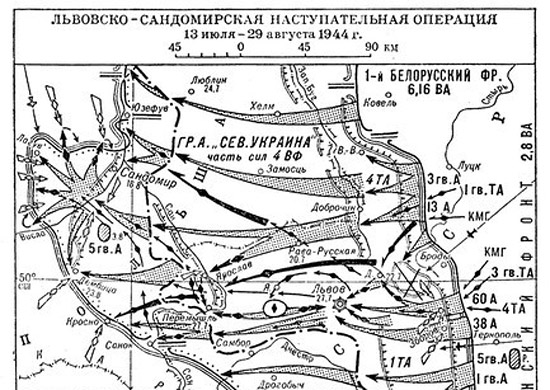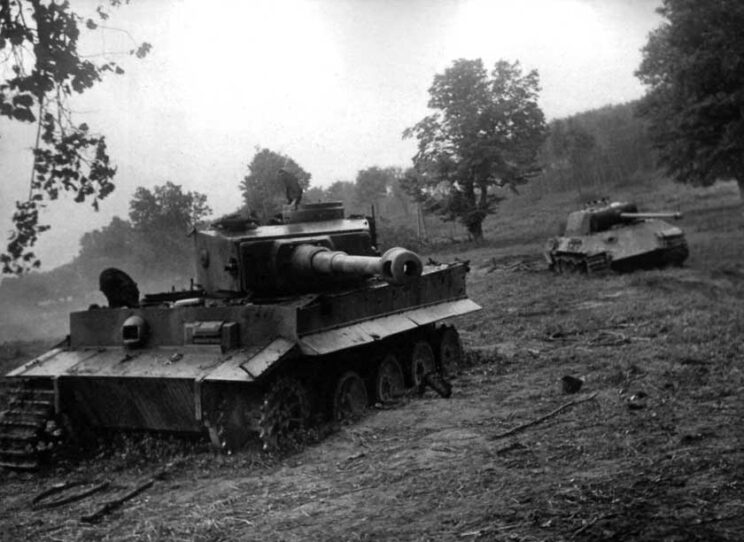
Lvov-Sandomierz offensive operation.
Content

German tanks PzKpfw VI Tygrys and PzKpfw V Pantera, shot down in the Drokhobych area; Western Ukraine, August 1944
The successful actions of the Soviet troops in Belarus created favorable conditions for the offensive of the 1944th Ukrainian Front (1st UV) in the Lvov-Sandomierz direction by mid-July 1. On May 25, the march took command of the 1st FI from Marshal Georgy Zhukov. Ivan Konev.
At the turn of 440 km, going west of Kovel, Tarnopol and Kolomyia, the army group "Northern Ukraine" under the command of Field Marshal Walter Model occupied the overwhelming part of its forces. It included the German 1st and 4th tank armies, as well as the 1st Hungarian army, in total 34 infantry divisions, 5 tank divisions, 1 motorized and 2 infantry brigades. Together it was more than 600 6300 soldiers and officers, 900 guns and mortars, 4 tanks and assault guns. At the same time, parts of the left wing of the 1st Panzer Army were ahead of the troops of the 4th Belorussian Front. 700 aircraft were deployed to support the defensive operations of the XNUMXth Air Fleet. The German command hoped that with these forces it would hold part of Ukraine in its hands, and also cover the directions leading to the south of Poland and Czechoslovakia, which were of great economic and strategic importance.
Having suffered a defeat in the right-bank Ukraine and expecting new "Stalinist blows", the Germans definitely strengthened and improved their defensive positions, especially in the Lvov direction. Three lines of defense were created on it, but before the start of the offensive of the Soviet troops, only two were prepared, creating a tactical line of defense. Five tank divisions, one motorized and three infantry divisions served in reserve with the commanders of the armies and the GA "Northern Ukraine".
Lvov operation
The 1st Ukrainian Front included: 1st, 3rd and 5th guards, 13th, 18th, 38th and 60th armies, 1st and 3rd guards and 4th i tank armies, 2nd air army, 4th guards, 25th and 31st tank corps, 1st and 6th guards cavalry corps. Corps, as well as the Czechoslovak 1st Army Corps. In total, the front included 74 infantry divisions, 6 cavalry divisions, 4 artillery divisions, 1 mortar division of the Guardians (artillery rocket launchers), 3 mechanized corps, 7 tank corps, 4 separate armored brigades, 17 separate tank regiments and self-propelled guns. - about 1,2 million soldiers and officers, 15 guns and mortars, 500 artillery rocket launchers, 1056 tanks and 1667 self-propelled guns, 529 combat aircraft. It was the largest front-line group of all formed so far.

A column of soldiers of the Hungarian army passes by the car of the commander of the GA "Northern Ukraine" Field Marshal Walter Model.
In connection with the expected operation, the Supreme Commander-in-Chief held a special meeting in the Kremlin on June 23, at which Konev reported on his decision to launch two strikes: on the Lvov and Ravsko-Rusyn directions. This made it possible to split the combat group of the GA "Northern Ukraine", encircle and destroy the enemy in the Brody area. The plan caused reservations from Stalin, who considered it pointless to disperse forces in the main areas. The “chief” ordered to strike one blow - at Lvov, investing all his strength and means into it.
The horse parried, arguing that a strike in one direction would allow the enemy to maneuver tactical and motorized tactical units in reserve and concentrate all aircraft in one place. In addition, an attack by one of the strike groups in the most fortified sector will lead not to a breakthrough of the defense, but to a stubborn breakthrough of successive lines of defense and will not create great operational capabilities. In the end, the front commander defended his point of view. On June 24, Stalin approved the operation plan proposed by the front, but in parting he said: Keep in mind, Konev, that the operation should go smoothly and bring the expected result.
The task of the front was: to break through the GA "Northern Ukraine", complete the liberation of Ukraine and transfer hostilities to the territory of Poland. The operation was carried out in cooperation with the troops of the 1st Belorussian Front advancing on Lublin. It was supposed to inflict two powerful blows on the right wing and in the middle and break the front into two sections, 60-70 km apart from each other. The first was supposed to be made from the area west of Lutsk in the direction of Sokal and Rava Russkaya, the second - from the Tarnopol region to Lvov, with the task of defeating the Lvov group of Germans, capturing Lvov and the Przemysl fortress.
The strike force in the Lutsk direction included: the 3rd Guards Army of Gordov Vasily Grigorievich, the 13th Army of Lieutenant General Nikolai Pavlovich Pukhov, the 1st Guards Tank Army of Colonel General Katukov M.E., Cavalry Mechanized Group (in consisting of the 25th Tank Corps and the 1st Guards Cavalry Corps) under the command of Lieutenant General Viktor Baranov. The attack was supported by four aviation corps of the 2nd Air Army.
The “fist” that was supposed to strike in the Lvov direction included: the 60th Army of Colonel General Pavel A. Kurochkin, the 38th Army of Colonel General Kirill Sergeevich Moskalenok, the 3rd Guards Tank Army of Colonel General Pavel Rybalka , 4th Army: Tank Army of Lieutenant General Dmitry Lkhatenko, Cavalry Mechanized Group of Lieutenant General Sergei Sokolov consisting of: 31st Tank Corps and 6th Guards Cavalry Corps. Air support was provided by five air corps.
In the strike force advancing on Lutsk, it was supposed to concentrate 12 rifle divisions, two tank corps, one mechanized and one cavalry, two artillery divisions of the breakthrough - 14 guns and mortars, 3250 tanks and self-propelled guns. self-propelled guns, 717 aircraft. On the 1300-kilometer section of Lvov, 14 infantry divisions, four tank, two mechanized and one cavalry corps, as well as two breakthrough artillery divisions - 15 guns and mortars, 3775 tanks and self-propelled guns, 1084 aircraft were supposed to strike.
On the fifth day of the operation, the 3rd Guards and 4th Tank Armies, in deep flank attacks south and north of Lvov, reached the Nemirov-Yavorov line, at a considerable distance west of the city.
On the left wing of the front, in the foothills of the Carpathians, the troops of the 1st Guards Army, Colonel General Andrei Grechka and the 18th Army, Lieutenant General Evgeny Petrovich Zhuravlev were stationed. Taking advantage of the success of its neighbors, the Greek army, having created a strike group of five infantry divisions and the 4th Guards Tank Corps, was supposed to go on the offensive, seize a bridgehead in the Galich region, thus covering the actions of troops in the direction of Lvov. The Zhuravlev Army, operating south of the Dniester, had the task of holding the occupied borders and being ready for an offensive in the Stanislavov direction.
In the reserve of the front was the 5th Guards Army (nine divisions) of Colonel-General Alexei Sergeevich Zhadov, transferred from the 2nd Ukrainian Front, as well as the 47th Rifle Corps by order of the Headquarters of the Supreme High Command.
Having launched an offensive, the strike groups were to defeat the main enemy forces, and part of their troops were to make a detour in converging directions and destroy the German formations in the Brody area. Then they were to take the city, developing the offensive and bypassing Lvov from the north and southwest. On the fifth day of the operation, it was planned to reach the border: Hrubieszow - Tomaszow - Nemirov - Yavoruw - Radlów. At the second stage of the operation, the strike was transferred to the Sandomierz direction in order to force the Vistula and create a large operational foothold near Sandomierz. In practice, the organization of the encirclement was associated with significant difficulties, since the front on the line of deployment of the shock groups stretched in a straight line, without any bends.
On July 10, the Headquarters finally approved the plan of operation. An order was also given to use armored armies and a mechanized cavalry group to break through the defense, and doubts were expressed about the possibility of crossing the terrain on foot at a speed of 35 km per day, as Konev determined. The front commander was forced to agree and make changes to the plan for the use of armored armies: now they were to be brought into battle on the second day of the operation after the combined arms armies had broken through the enemy's tactical defense belt.
To camouflage the preparation of the operation, the front headquarters developed an operational camouflage plan, which provided for the simulation of the concentration of two armies and a tank corps on the left wing of the front, in the bands of the 1st Guards Army and the 18th Army. Therefore, a large-scale imitation of the rail transportation of tanks and self-propelled guns began, the areas for unloading armored groups were simulated, routes for their march to the areas of concentration were outlined, and intensive correspondence was conducted in the air. A large number of models of tanks, vehicles, artillery and other equipment were exhibited at the fake sites. Fake airfields with mock-ups of planes were covered with the duty keys of fighters to emphasize their authenticity. Reconnaissance groups stopped in many settlements, choosing places to accommodate "arriving headquarters and troops."

Hungarian and German tankers with PzKpfw VI Ausf. E Tiger; Western Ukraine, July 1944
Despite the use of the strictest means of disguise, it was not possible to completely deceive the enemy. The Germans expected the advance of the troops of the 1st Ukrainian Front, mainly in the direction of Lviv, where operational reserves were deployed - the 1st Panzer Corps (8th and 20th Panzer Divisions and the 1st Motorized Division) of General Herman Breit. They identified the disposition and composition of the combined arms armies, determined the directions of the impending strikes, and planned countermeasures, especially the withdrawal to the second line of defense along a large sector of the front. The commander of the 160th Panzer Army, General Erhard Raus, recalled that he knew with sufficient accuracy the direction of the main Rusyn attack, to which his sappers put up 200 people. anti-personnel mines and XNUMX thousand anti-tank mines. Covert withdrawal, stubborn resistance in depth, counterattacks without delay using high-speed formations - such was the tactics of the German defense. Only the time was unknown, the general withdrew his troops from the first line of defense for three nights in a row, only to then order them to return to the previously occupied line. True, they failed to detect the redeployment of Katukov's tank army south of Lutsk.